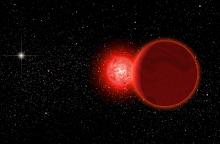Listen to today's episode of StarDate on the web the same day it airs in high-quality streaming audio without any extra ads or announcements. Choose a $8 one-month pass, or listen every day for a year for just $30.
You are here
Redshift
The most-distant objects we can see are galaxies more than 13 billion light-years away. That means we see them as they looked just a few hundred million years after the Big Bang. We know their distance because astronomers measure their cosmological redshift — an effect caused by the expansion of the universe.
As the universe expands, it “stretches” the wavelengths of light produced by stars and galaxies. The greater the distance, the more the light is stretched.
Astronomers measure that effect by looking for the “barcodes” that different chemical elements imprint in the object’s light. Each barcode keeps the same pattern. But it appears at a different place in the object’s spectrum — the “rainbow” of colors produced when you break the light into its individual wavelengths. When an object is moving away from us, the patterns are shifted to longer wavelengths — toward the red end of the spectrum — the redshift.
For galaxies that are especially far away, the wavelengths can be shifted into the infrared. But Earth’s atmosphere absorbs most infrared light. So the best way to study it is from space.
But most telescopes in space aren’t big enough to see deeply into the universe, so they can’t see the earliest galaxies — or if they do see them, the galaxies look like fuzzy red blobs. Only one space telescope allows us to see those early galaxies as galaxies — Webb Space Telescope. More about that tomorrow.
Script by Damond Benningfield





